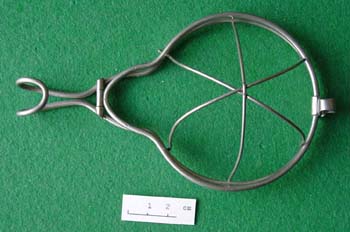 |
|
Mask from ESMARCH
|
The pleasant smell and less mucous membrane irritation of the chloroform immediately caused a wide distribution of this anesthetic, which proved particularly useful in obstetrics. Even VELPEAU in France, who in 1840 had said "éviter la douleur dans les opérations est une chimère qu'il n'est pas permis de poursuivre aujourd'hui", had himself converted to the new procedure. In 1853, for example, the English Queen Victoria was released in chloroform intoxication - the "anesthesia à la reine" became the hit of high society.
Several methods competed to apply the chloroform:
- the sponge, which was pressed directly on the nose,
- The 1862 specified mask of the birthing aid Thomas SKINNER from Liverpool, which was covered with gauze
- the 1877 mask of A. von ESMARCH.
"The Esmarch mask is, in principle, a wire mask covered with a cloth, a construction that modified and improved the mask of the Englishman Thomas SKINNER as early as 1862. By dropping chloroform on the fabric, the anesthetic volatilized and could now be vaporized as vapor A significant improvement over the previous method of chloroform pouring on a cloth or sponge, which was pressed directly to the patient's mouth and nose, with the dropwise application of the chloroform to the mask the considerably better dosability of the anesthetic, for mixing with a lot of fresh air and thereby to a drastic reduction of the risk of hypoxia "(Wolfgang Regal).
The mask presented here served for many years our colleague dr. Emil GRETSCH (1908-2004) "anaesthésie à la reine" for births at Maternité Charlotte.
|




